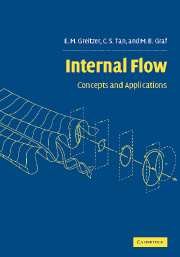Book contents
- Frontmatter
- Contents
- Preface
- Acknowledgements
- Conventions and nomenclature
- 1 Equations of motion
- 2 Some useful basic ideas
- 3 Vorticity and circulation
- 4 Boundary layers and free shear layers
- 5 Loss sources and loss accounting
- 6 Unsteady flow
- 7 Flow in rotating passages
- 8 Swirling flow
- 9 Generation of streamwise vorticity and three-dimensional flow
- 10 Compressible internal flow
- 11 Flow with heat addition
- 12 Non-uniform flow in fluid components
- References
- Supplementary references appearing in figures
- Index
1 - Equations of motion
Published online by Cambridge University Press: 14 January 2010
- Frontmatter
- Contents
- Preface
- Acknowledgements
- Conventions and nomenclature
- 1 Equations of motion
- 2 Some useful basic ideas
- 3 Vorticity and circulation
- 4 Boundary layers and free shear layers
- 5 Loss sources and loss accounting
- 6 Unsteady flow
- 7 Flow in rotating passages
- 8 Swirling flow
- 9 Generation of streamwise vorticity and three-dimensional flow
- 10 Compressible internal flow
- 11 Flow with heat addition
- 12 Non-uniform flow in fluid components
- References
- Supplementary references appearing in figures
- Index
Summary
Introduction
This is a book about the fluid motions which set the performance of devices such as propulsion systems and their components, fluid machinery, ducts, and channels. The flows addressed can be broadly characterized as follows:
There is often work or heat transfer. Further, this energy addition can vary between streamlines, with the result that there is no “uniform free stream”. Stagnation conditions therefore have a spatial (and sometimes a temporal) variation which must be captured in descriptions of the component behavior.
There are often large changes in direction and in velocity. For example, deflections of over 90° are common in fluid machinery, with no one obvious reference direction or velocity. Concepts of lift and drag, which are central to external aerodynamics, are thus much less useful than ideas of loss and flow deflection in describing internal flow component performance. Deflection of the non-uniform flows mentioned in (1) also creates (three-dimensional) motions normal to the mean flow direction which transport mass, momentum, and energy across ducts and channels.
There is often strong swirl, with consequent phenomena that are different than for flow without swirl. For example, static pressure rise can be associated almost entirely with the circumferential (swirl) velocity component and thus essentially independent of whether the flow is forward (radially outward) or separated (radially inward). In addition the upstream influence of a fluid component, and hence the interaction between fluid components in a given system, can be qualitatively different than that in a flow with no swirl.
[…]
- Type
- Chapter
- Information
- Internal FlowConcepts and Applications, pp. 1 - 47Publisher: Cambridge University PressPrint publication year: 2004
- 1
- Cited by



